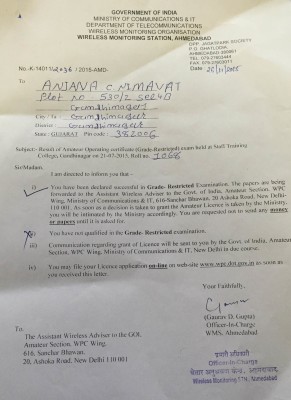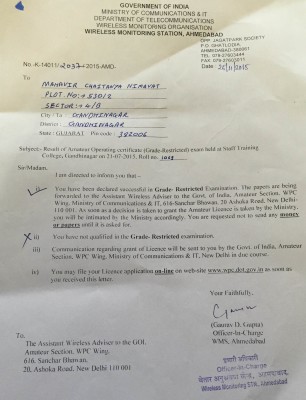Congratulations our trust president Anjana C Nimavat and Volunteers Mahavir C Nimavat, Ashutosh Tiwary, Pruthak Thakkar for passing ham radio exam. After 3 to 4 months exam result is declared by Gujarat Institute Of Amateur Radio (GIAR). Specially Thanks To Gandhinagar wireless PI Pravin Valera sir to guide our Volunteers regarding Ham Radio.

Amateur radio, also known as ham radio, is a hobby enjoyed by several hundred thousand people in the United States and by over a million people worldwide. Amateur radio operators call themselves “radio hams” or simply “hams.”
To become a radio ham, you must pass an examination. Wireless amateur communication is done on numerous bands (relatively narrow frequency segments) extending from 1.8 MHz (a wavelength of about 160 meters) upwards through several hundred gigahertz (wavelengths in the millimeter range). There are several license classes. The more privileges a class of license conveys, the more difficult is the examination that one must pass to obtain it.
Amateur radio operation is fun, and that is one of the main reasons hams do it. But ham radio can provide communication during states of emergency. Ham radio works when all other services fail. After Hurricane Andrew struck South Florida in 1992, the utility grid was destroyed over hundreds of square miles. All cellular towers and antennas were blown down. Only amateur radio, the Citizens Radio Service (“Citizens Band”), and a few isolated pay phones with underground lines provided communication between the outside world and the public in the affected area.
Amateur radio operators are known as technical innovators, and have been responsible for important discoveries. For example, in the early part of the 20th century, government officials believed that all the frequencies having wavelengths shorter than 200 meters (1.5 MHz) were useless for radio communications, so they restricted radio amateurs to these frequencies. It was not long before ham radio operators discovered the truth, and were communicating on a worldwide scale using low-power transmitters. Thus the shortwave radio era began.


